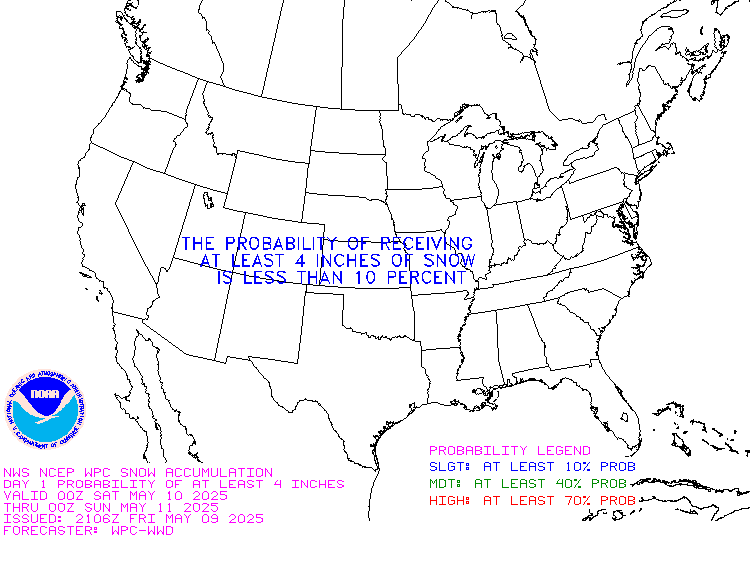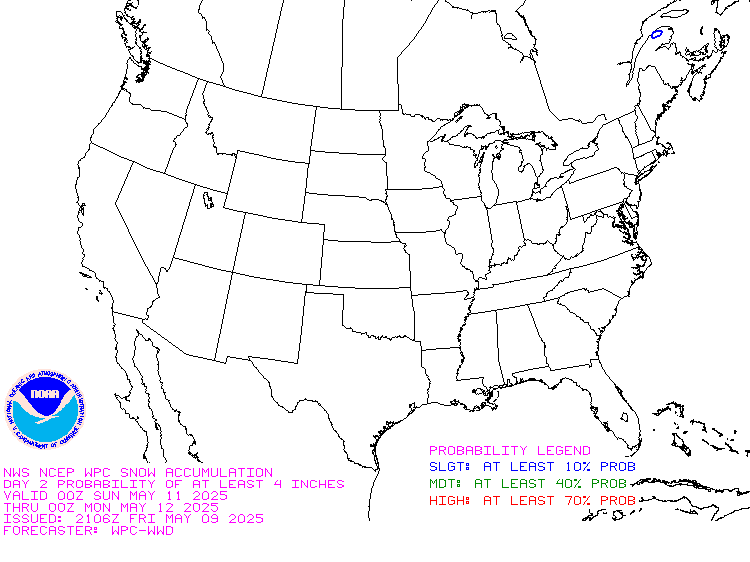It is difficult to find a more comprehensive Weather Outlook anywhere else with the ability to get a local 10-day Forecast also.
This article focuses on what we are paying attention to in the next 48 to 72 hours. The article also includes weather maps for longer-term U.S. outlooks and a six-day World weather outlook which can be very useful for travelers.
First the NWS Short Range Forecast. The afternoon NWS text update can be found here but it is unlikely to have changed very much. The images in this article automatically update.
Short Range Forecast Discussion
NWS Weather Prediction Center College Park MD
400 AM EDT Wed Apr 03 2024Valid 12Z Wed Apr 03 2024 – 12Z Fri Apr 05 2024
…Heavy snow over the Upper Great Lakes, Upstate New York, and Northern
New England on Wednesday; Heavy snow over the Sierra Nevada Mountains and
Central Appalachians on Thursday……There is a Slight Risk of excessive rainfall over parts of the
Mid-Atlantic and Southern New England on Wednesday……There is a Sight Risk of severe thunderstorms over parts of the
Mid-Atlantic Coast to the Southeast Coast and Florida peninsula on
Wednesday…A deep storm over the Great Lakes will move southeastward to the
Mid-Atlantic Coast by Thursday evening and northeastward to the Gulf of
Maine by Friday. The system will produce a late-season winter storm across
portions of the Great Lakes and the Northeast from Wednesday into Friday.
The western portion of the Upper Peninsula of Michigan is forecast to
receive heavy snow through Wednesday evening. Snowfall accumulations of as
much as 1 to 2 feet are expected in parts of northern Wisconsin and the
western portion of the Upper Peninsula of Michigan.The same storm will produce Northeast snow and wind Wednesday through
Friday. Heavy, wet snow and some sleet will spread into the Northeast on
Wednesday and continue into Friday. Portions of northern New York and
Northern New England will likely see significant snow accumulations of
over 12 inches.The system will create significant impacts from heavy snow and wind, and
the combination of heavy snow rates and gusty winds will lead to dangerous
travel conditions, with whiteout conditions and snow-covered roads. The
combination of wet snow, high snow load, and strong wind gusts could also
result in tree damage and power outages. On Thursday, heavy snow will
develop over parts of the Central Appalachians.Furthermore, prolonged onshore winds late Wednesday and continuing through
Thursday will result in moderate coastal flooding for portions of the
Northeast Coast. Impacts include widespread roadway flooding, coastal and
bayside flooding, impassable roads, and some damage to vulnerable
structures.Moreover, along the associated front extending from the Lower Great Lakes
to the Central Appalachians southward to the Central Gulf Coast will move
off most of the East Coast overnight Wednesday. The boundary will aid in
producing showers, and severe thunderstorms will develop over parts of the
Mid-Atlantic and Southeast Coast. Therefore, the SPC has issued a Slight
Risk (level 2/5) of severe thunderstorms over parts of the Mid-Atlantic
Coast to the Southeast Coast and Florida peninsula through Thursday
morning. The hazards associated with these thunderstorms are frequent
lightning, severe thunderstorm wind gusts, hail, and a few tornadoes.Showers and thunderstorms will produce heavy rain over parts of the
Mid-Atlantic and Northeast. Therefore, the WPC has issued a Slight Risk
(level 2/4) of severe thunderstorms over parts of the Mid-Atlantic and
Southern New England through Thursday morning. The associated heavy rain
will create mainly localized areas of flash flooding, with urban areas,
roads, and small streams the most vulnerable. The threat of severe
thunderstorms and excessive rainfall ends on Thursday.Meanwhile, a front moving inland over the Pacific Northwest into Northern
California will move eastward to the Northern Rockies to the Great Basin
and Southwest by Friday. On Wednesday, the system will create coastal rain
and higher-elevation snow over parts of the Pacific Northwest/ Northern
Intermountain Region, moving inland to the Northern Intermountain Region,
Great Basin, and Northern California overnight. The snow levels will lower
after the front passes by over the Northwest. The coast/lower elevation
rain and higher elevation snow will continue over the Pacific
Northwest/Northern Intermountain Region through Friday.On Thursday, rain and higher-elevation snow will move into Central
California and expand into the Great Basin. Overnight Thursday, rain will
move into Southern California. Heavy snow will develop over the Sierra
Nevada Mountains on Thursday into Friday.
To get your local forecast plus active alerts and warnings click HERE and enter your city, state or zip code.
Above is a 72 hour animation of the forecast. Learn about wave patterns HERE.
Then, looking at the world and of course, the U.S. shows here also. Today we are looking at precipitation.
Please click on “Read More” below to access the full Daily Report issued today.
| Notices: What would you like to learn about? Please provide that to me via the comment section at the end of the article. |
Now more detail on the 48-Hour Forecast (It is a 48 to 72 Hour Forecast actually)
Daily weather maps. The Day 1 map updates twice a day and the Day 2 and 3 maps update only once a day. These maps update automatically. But if that does not happen, you can get updates by clicking HERE
TODAY (or late in the day the evening/overnight map will appear) (Key to surface fronts shown on maps and you will then also be able to insert a city name or zip code and get a local NWS forecast).
TOMORROW
NEXT DAY
This animation shows how things may play out over the next 60 hours. To update click here.
The NWS Climate Prediction Center’s: Watches, Warnings, and Advisories plus other information can be found HERE. We post at least one of those updates daily, sometimes both. The Highlights are shown in the lede paragraph of this article.
ATMOSPHERIC RIVERS
This tells us what is approaching the West Coast. Click HERE to update If I have not gotten around to doing the update. Here is some useful information about Atmospheric Rivers.
Below is the current five-day cumulative forecast of precipitation (Updates can be found HERE)
Ski SnowReports
New Feature – Ski Reports. It is difficult to find reports that auto-update on-screen (and they are very long) but these links will get you to them – If you have additional suggestions make them in the comments section after every Econcurrents Article and we may add those links. We will try to not have too much overlap as that can add to the confusion.
Snow Forecasts. And remember this shows natural snow. Ski resorts also make their own snow.
Day 1

Day 2

Additional snow information can be found here, here, here, and here. The second link provides animations.
Now we look at Intermediate-Term “Outlook” maps for three time periods. Days 6 – 10, Days 8 – 14, and Weeks 3 and 4. An outlook differs from a forecast based on how NOAA uses these terms in that an “outlook” presents information as deviation from normal and the likelihood of these deviations.
Below are the links to obtain updates and additional information. They are particularly useful if you happen to be reading this article significantly later than when it was published. I always try to provide readers with the source of the information in my articles. These links may also be useful for those viewing this article on a cell phone or other small screen.
| Days 6 – 10 (shown in Row 1) | Days 8 – 14 (Shown in Row 2) | Weeks 3 and 4 (Shown in Row 3 but updates only on Fridays) |
| https://www.cpc.ncep.noaa. gov/products/predictions/610day/ | https://www.cpc.ncep .noaa.gov/products/predictions/814day/ | https://www.cpc.ncep.noaa.gov/products/predictions/WK34/ |
Showing the actual maps. They should now update automatically. The Week 3 – 4 Outlook only updates on Fridays. So below is what I call the Intermediate-term outlook. On Fridays, it extends out 28 Days. That declines day by day so on Thursday it only looks out 22 days until the next day when the Week 3 – 4 Outlook is updated and this extends the outlook by one additional week.
| 6–
10
|
|
|
| 8–
14 |
|
|
| 3–
4 |
|
|
HAZARDS OUTLOOKS
Click here for the latest complete Day 3 -7 Hazards forecast which updates only on weekdays. Once a week probably Monday or Tuesday I will update the images. I provided the link for readers to get daily updates on weekdays. Use your own judgment to decide if you need to update these images. I update almost all the images Friday Night for the weekend edition of this Weather Report. So normally readers do not need to update these images but if the weather is changing quickly you may want to.
Temperature month to date can be found at https://hprcc.unl.edu/products/maps/acis/MonthTDeptUS.png
Precipitation month to date can be found at https://hprcc.unl.edu/products/maps/acis /MonthPNormUS.png
World Forecast [that website is has been intermittent so be patient]
Below are the Day 1 -3 and 4-6 forecasts for temperature and precipitation. Updates and much additional information can be obtained HERE
World Temperature Anomalies
World Accumulated Precipitation
This information is provided by the University of Maine. They draw upon many different sources. There is a lot of information available at the link provided. I have just provided two useful forecasts. There are probably over a hundred different forecasts available from this source.
Worldwide Tropical Forecast (This is a NOAA Product)
This graphic updates on Tuesdays) If it has not been updated, you can get the update by clicking here Readers will only have to do that if they are reading this article much later than the date of it being published.
Information on Tropical Storms can be found HERE. Western Pacific information can be found HERE. Note that unless there is an out-of-season storm the below images will not update until the National Hurricane Center starts their seasonal update of these maps on June 1. I include them simply because there can be an out-of-season event in which case it should show up in these maps.


–
| I hope you found this article interesting and useful. |
–

